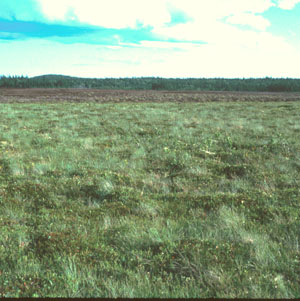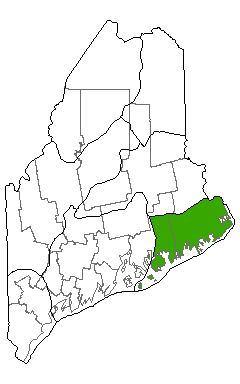DACF Home → Bureaus & Programs → Maine Natural Areas Program → Communities, Plants, and Animals → Natural Community Fact Sheets → Coastal Sedge Bog
Printer Friendly Fact Sheet - 1.2 MB pdf (Get a free copy of Adobe Acrobat Reader)
Coastal Sedge Bog
Scientific Name: Deer-hair Sedge Bog Lawn; State Rank: S2

- Community Description
- Soil and Site Characteristics
- Diagnostics
- Similar Types
- Conservation, Wildlife and Management Considerations
- Distribution
- Characteristic Plants
- Associated Rare Plants
- Associated Rare Animals
- Examples on Conservation Lands You Can Visit
Community Description: This raised bog type is dominated by carpets or patches of deer-hair sedge, often with very stunted (<0.3 m) heath shrubs such as black crowberry, dwarf huckleberry, or leatherleaf. Round-leaved sundew, pitcher plant, and small cranberry grow among the peat mosses, which form a dense and spongy ground layer. Reindeer lichen are scattered among the mosses. Back to top.
Soil and Site Characteristics: This community is restricted to raised bogs along or near the coast, often forming expansive "lawns” on the raised portions. The substrate is saturated, acidic (pH ~4.5) peat moss. As with other bog vegetation, it occurs in nutrient poor, usually ombrotrophic settings. Back to top.
Diagnostics: Sites are in a peatland setting, with a dominance of deer-hair sedge and a lack of other circumneutral indicators. Dwarf huckleberry is characteristic but not dominant. Back to top.
Similar Types: Circumneutral Fens can also be dominated by deer-hair sedge but are in fens, not raised coastal bogs, lack dwarf huckleberry, and have other circumneutral indicators present such as shrubby cinquefoil or certain sedges. Maritime Huckleberry Bogs can occur in similar settings to Coastal Sedge Bogs, and can share many species, but will have dwarf shrubs more dominant than sedges; the two types may occur adjacent to each other with a continuous gradation from one type to the next. Back to top.
Conservation, Wildlife and Management Considerations: This community type is not widely distributed, but has been subject to few threats to date. Slow vegetation growth rates, due to the nutrient poor setting, mean slow recovery from physical disturbances, such as recreational use. If disturbance, such as foot traffic, is a necessity, traversing during frozen conditions or using boardwalks can minimize impacts. Peat harvesting could threaten some sites but is not currently much of a factor. Draining or other hydrologic changes would have negative impacts on bog vegetation. Several occurrences are on public lands or private conservation lands.
The rare crowberry blue butterfly is restricted to coastal heaths in east-coastal Maine. It uses black crowberry as a larval host plant. Back to top.
Distribution: Downeast Maine, extending eastward into the Canadian Maritimes (Laurentian Mixed Forest Province). Landscape Pattern: Small Patch, interspersed with other peatland types. Back to top.


Characteristic Plants: These plants are frequently found in this community type. Those with an asterisk are often diagnostic of this community.
- Sapling/shrub
- Black chokeberry
- Mountain holly
- Dwarf Shrub
- Black crowberry*
- Dwarf huckleberry*
- Labrador tea
- Leatherleaf*
- Pale laurel
- Sheep laurel*
- Small cranberry
- Herb
- Bog goldenrod
- Coast sedge*
- Deer-hair sedge*
- Horned bladderwort
- Pitcher plant
- Round-leaved sundew
- Bryoid
- Bog broom-moss
- Bog hair-cap moss
- Little-tree reindeer-lichen
- Sphagnum rubellum*
There are no documented rare plants associated with this natural community.
- Crowberry blue
Examples on Conservation Lands You Can Visit
| Example | County |
|---|---|
| Acadia National Park | Hancock Co. |
| Great Heath Public Lands | Washington Co. |
| Great Wass Island Preserve | Washington Co. |
| Larrabee Heath Preserve | Washington Co. |
| Quoddy Head State Park | Washington Co. |